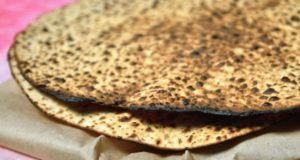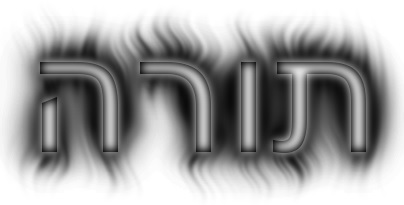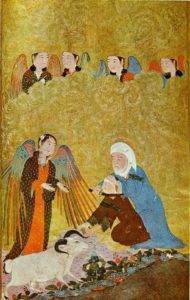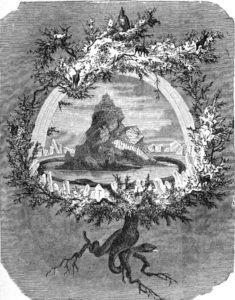For more on ‘Judaism vs. Christianity’, please see here.
Tag Archives: 613 Commandments
Jews and Christmas Trees
As we approach Christmas and New Year’s Eve and start seeing “Christmas trees” popping up all around us, it is worth exploring where this custom came from, and what the Torah might say about it. It is especially important to address because some Jews from the former Soviet Union continue to have a (seemingly) non-religious “New Year’s tree” yolka in their homes, as do assimilated and intermarried Jews across Europe and America. Is it okay to have such a tree in a Jewish home? As might be expected, the short answer is “no”. To properly understand why, we must take an eye-opening trip back in time.
The ancient Nordic and Germanic tribes celebrated a winter solstice festival usually referred to as Yule. Part of the ritual involved worshipping and decorating an evergreen tree, which symbolized life in the dead of winter. Many tribes associated the tree with Odin, the “father of all the gods” in Norse mythology. He was the most powerful figure in the Nine Worlds, represented by Yggdrasil, the sacred tree. Yggdrasil was a “tree of life” of sorts, while beneath its roots lay Hel, the underworld of the dead, and the origin of the English word “hell”. The word Yggdrasil itself means “Odin’s horse” or “Odin’s gallows” (Ygg, or Yggr, is another name for Odin). Others associated the tree with another powerful deity, Thor, “god of thunder”, Odin’s son and protector of Earth. (Fun fact: Wednesday and Thursday are named after Odin and Thor, ie. Odin’s-day and Thor’s-day!)
In 723 CE, the Christian missionary Boniface went forth to convert the pagan Germanic tribes. He came upon a village in the midst of worshipping an oak tree in honour of Thor and were apparently about to sacrifice a baby. Boniface took an axe and chopped the tree down—according to legend, miraculously in one swipe. He didn’t do away with the tree-worshipping ritual entirely, though, and offered the pagans a way to hold on to their old customs: Boniface pointed to a baby fir tree and said “let this tree be the symbol of the true God”. So goes the story, anyways.
While the Germanic and Nordic tribes were all eventually converted to Christianity (some by choice, most by force), they retained many of their old customs. Another example: In Norse myth, “Father Odin” (with his long white beard) would go around on his eight-legged horse to deliver gifts at Yule-time, with the help of the alfar, “elves”, which play an important role in the Norse worldview. “Father Odin” became “Father Christmas”, ie. Santa Claus. To make this less pagan and more palatable to Christians, the figure of Santa Claus was eventually associated with “St. Nicholas” instead, much like the pagan evergreens became symbolic of the Tree of Life in the Garden of Eden. In fact, the spherical red ornaments commonly hung on Christmas trees evolved from apples once hung on Christmas trees to represent the Forbidden Fruit.
There is a great deal of irony here, in that something symbolizing life is chopped down and killed! (And plastic tree alternatives are no better, for they will go on to contaminate the Earth with toxic chemicals for centuries.) It is fitting, then, that the Christmas tree is decorated with “apples” of the Forbidden Fruit, which did not grow on the Tree of Life, but rather on the Tree of Knowledge which brought death into the world. Rabbi Abraham Abulafia (c. 1240-1291), one of the great Sephardic mystics, in his Sefer Sitrei Torah, likened the wooden cross upon which Jesus presumably died to the Tree of Knowledge. (In Hebrew, the word for “wood” and the word for “tree” is the same, etz.) Jesus claimed to be the Tree of Life, the only path to eternal life in Heaven, and for this preposterous claim—supplanting the singular God and His Torah—he was punished measure for measure by being killed on a “tree of death”.
Abulafia held that believing in Jesus was undoubtedly a form of idolatry (and, for those who like numbers, he gave a further mathematical proof in that the gematria of “Jesus”, Yeshu [ישו] is 316, equal to “elohei nekhar”, אלהי נכר, the Torah term for a foreign or false god). We should remember to stick to the one true God and His Torah alone for, as King Solomon said, “it is a Tree of Life for those who grasp it, and whoever upholds it is fortunate.” (Proverbs 3:18) In case anyone was doubting what Solomon was referring to here, he began by stating Torati al tishkach, “do not forget My Torah, and may My mitzvot always be upon your heart.” (Proverbs 3:1) The Torah, and fulfilment of its mitzvot, alone holds the true spiritual path—that is the Tree of Life.
One of those 613 mitzvot of the Torah is not to worship trees, nor bring trees anywhere near the sacrificial altar in the Temple, not even to plant trees that might later be used for worship (Deuteronomy 16:21). Throughout the rest of Scripture, we find that Jews unfortunately sometimes went astray and succumbed to the idolatries of the nations around them, including worshipping Asherah trees and using them as ritual objects. The prophet Jeremiah warned us long ago: “Thus said God: Do not learn from the ways of the nations… for their customs are worthless; they chop down a tree from a forest, they adorn it with silver and gold…” (Jeremiah 10:2-4) As such, there is certainly no room for Christmas trees in a Jewish home. But what if the trees are devoid of any religious significance?
Yolka
After the October Revolution of 1917, the Communists in Russia went on to ban all religious activity, including Christmas trees. Nonetheless, as the famous saying goes, “old habits die hard”, and people weren’t willing to give up on their customs. Thus, just as Boniface had done centuries earlier, the leaders of the USSR decided to simply replace the symbolism. In 1935, they reintroduced the ritual as a novogodniya yolka, a “New Year’s tree”, along with Dyed Moroz, “Grandpa Frost”, and his snowy female helper Snigurachka, in place of the more religious Santa Claus and his mystical elves. Instead of Christmas Eve, Dyed Moroz would come on New Year’s Eve. (Interestingly, the mysterious word yolka probably comes from that pagan Yule festival.)
In the past, we’ve written about the permissibility of Jews celebrating the secular New Year’s Eve. While there is some leniency regarding New Year’s Eve, the tree in the home is an entirely different issue. When the Torah is so explicit about avoiding any tree rituals, and considering how strongly the Tanakh cautions us about Jews going astray and mimicking the tree-customs of the nations, and keeping in mind how the origins of the tree are deeply pagan first and foremost, as well as extensively Christian thereafter, it is important to stay away from anything remotely resembling a Christmas tree or yolka.
Thankfully, we have a much better tree-related celebration just a month or so after in Tu b’Shevat. This one requires no wanton destruction of trees, nor any pagan-like tree rituals, instead simply appreciating all the good that trees and plants do for us. And it comes with a mystical custom to hold a Tu b’Shevat seder, like on Pesach, symbolizing the forthcoming Final Redemption. When the actual Mashiach does come to usher in the Redemption, our Sages say he will “flourish like a palm tree; thrive like a cedar in the Lebanon.” (Psalm 92:13) May we merit to greet him soon.
The First Pesach: Did the Patriarchs Celebrate Passover?
 The holiday of Passover commemorates the Exodus of the Israelites out of Egypt over three thousand years ago. The Torah tells us that because of their hasty departure, the dough of the Israelites did not have time to rise, hence the consumption of matzah. Yet, the term matzah appears in the Torah long before the Exodus! We read in Genesis 19:3 that Lot welcomed the angels into his home and “made them a feast, and baked matzot, and they ate.” Since the angels came to Lot immediately after visiting Abraham and Sarah to announce the birth of Isaac at that time next year (Genesis 18:10), the Sages learn from this that Isaac was born on Passover. Of course, the Exodus only took place four hundred years after Isaac’s birth! How is it that the patriarchs are already eating matzah?
The holiday of Passover commemorates the Exodus of the Israelites out of Egypt over three thousand years ago. The Torah tells us that because of their hasty departure, the dough of the Israelites did not have time to rise, hence the consumption of matzah. Yet, the term matzah appears in the Torah long before the Exodus! We read in Genesis 19:3 that Lot welcomed the angels into his home and “made them a feast, and baked matzot, and they ate.” Since the angels came to Lot immediately after visiting Abraham and Sarah to announce the birth of Isaac at that time next year (Genesis 18:10), the Sages learn from this that Isaac was born on Passover. Of course, the Exodus only took place four hundred years after Isaac’s birth! How is it that the patriarchs are already eating matzah?
An Eternal Torah
Although the Torah was given to the Israelites following the Exodus, Jewish tradition affirms that the Torah is eternal, and even predates existence. A famous verse in the Zohar (II, 161a) states that “God looked into the Torah and created the universe.” Adam knew the whole Torah, and was taught its deepest secrets by the angel Raziel. Many of these teachings were passed on by Adam to future generations, down to Noah, then his son Shem, and eventually to the Patriarchs who, according to tradition, studied at Shem’s academy. So, while the Torah tradition officially dates back to Sinai, in some ways it dates back all the way to Creation! It’s also important to keep in mind that the Patriarchs were prophets, which means that even though they did not have a physical, written Torah, there is no reason why they could not have received the Torah’s wisdom directly from God.
As such, it is said that the Patriarchs kept the entire Torah and fulfilled all the mitzvot. When Jacob sends a message to Esau after his sojourn in Charan he tells him “I have lived [garti] with Laban” (Genesis 32:5). On this, Rashi says that garti (גרתי) is an anagram of taryag (תרי״ג), the 613 commandments, meaning that despite living under the oppressive Laban for twenty years, Jacob still observed all 613 commandments. Yet, this is impossible since Jacob married two sisters—a clear Torah prohibition! Similarly, when Abraham meets Melchizedek (ie. Shem) following his victory over the Mesopotamian kings, he tells him that he will not take any reward whatsoever, not even “a thread or strap” (Genesis 14:23). For this, the Sages say, Abraham’s descendants merited the mitzvah of tzitzit (the threads) and tefillin (the straps). In that case, Abraham himself did not wear tefillin or tzitzit. From such instances we see that the patriarchs did not keep the Torah completely, at least not the Torah as we know it.
Emanations of Torah
While Kabbalistic texts often point out that the Torah is eternal and served as the very blueprint of Creation, they also go into more detail to explain that this primordial Torah was not quite the same as the Torah we have today. Each of the four mystical universes (Asiyah, Yetzirah, Beriah, Atzilut) has an ever-more refined level of Torah, with the highest being the Torah of Atzilut. Our Torah is the one of Asiyah, and is full of mitzvot only due to Adam’s sin and the corruption of mankind. In Olam HaBa, the Torah of Atzilut will finally be revealed, which is why Jewish tradition holds that many mitzvot will no longer apply in that future time. This is said to be the meaning of Isaiah 51:4 where God proclaims that in the messianic times “a Torah will go forth from Me”; and of Jeremiah 31:30 where God says He will forge a brit chadashah, a “new covenant”, with Israel. (This latter term was usurped by Christians for their “New Testament”.)
An even more intriguing idea is that the “New Torah” will be composed of the exact same letters as the current one we possess, just rearranged to form new words! Yet another is based on the well-known principle that the Heavenly Torah is composed of “black fire on white fire”. This is often used to explain the fact that the Torah actually has 304,805 letters, even though it is always described as having 600,000 letters (one for each Israelite at Mt. Sinai)—there are 304,805 letters of “black fire” and the rest are the invisible letters of “white fire”. Gershom Scholem cites a number of Kabbalistic and Hasidic texts suggesting that these currently-invisible “white fire” letters are the true eternal Torah! (See Scholem’s Kabbalah, pgs. 171-174, for a complete analysis of these concepts.)

It is this primordial Torah that was originally taught to Adam, and was passed down through his descendants to the Patriarchs, who carefully observed it. As such, it appears that eating matzah is an eternal mitzvah that already appeared in the primordial Torah before the Exodus and the revelation of the current Torah of Asiyah. What was the meaning behind that consumption of matzah?
Bread of Faith
Matzah is called the “bread of faith”. It symbolizes our faithfulness to God, who took us out of Egypt to be His people: “Let My people go so that they may serve Me” (Exodus 7:16, 26). Further emphasizing this point, the word matzot is spelled exactly like mitzvot. This simple, “humble” bread symbolizes our subservience to God’s commands. We are His faithful servants, just as the Patriarchs were His faithful servants. So they, too, ate matzah as a sign of their faith. They ate matzah because God had liberated them, too, from various hardships.
The very first Patriarch, Abraham, was miraculously saved from Nimrod’s furnace. He also dwelled in Egypt for a time before God miraculously brought him out of there with great wealth, just as his descendants would do centuries later. And then came his greatest test of faith: the Akedah. Amazingly, the apocryphal Book of Jubilees connects this event with the future Passover holiday. In chapter 18, it suggests that God commanded the Akedah to Abraham on the 15th of Nisan. As the Torah states, Abraham journeyed for three days before the Akedah happened and then, naturally, it took him three days to return home. Thus, the whole ordeal spanned seven days, and when Abraham returned, he established a seven-day “festival to Hashem” from the 15th of Nisan. The future seven-day Passover holiday would happen on those same days in that same month.

“Abraham’s Sacrifice”, a 15th century piece of Timurid-Mongolian art
While the Sages do debate whether some of the Torah’s major events (including Creation itself) happened in the month of Tishrei or Nisan, the accepted Jewish tradition is that the Akedah happened in Tishrei. Nonetheless, it is quite fitting that the Binding of Isaac should happen on Passover, when Isaac was born. In this case, the ram that Abraham ultimately offered in place of Isaac would serve as a proto-Pesach offering. After all, the ram is nothing but a male sheep, and it is the ram that is the astrological sign of Nisan, and it was those ram-headed gods that the Egyptians worshipped that needed to be slaughtered by the Israelites (as discussed last week). Whatever the case, the Book of Jubilees offers an intriguing possibility for the spiritual origins of Passover, and for why the Patriarchs themselves ate matzot long before the Exodus.

